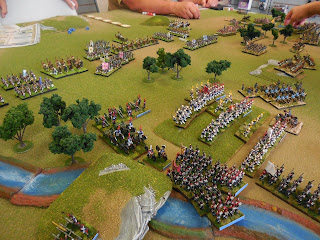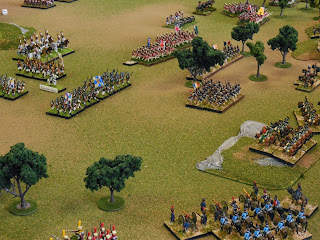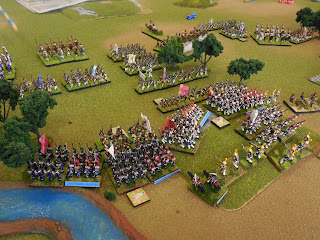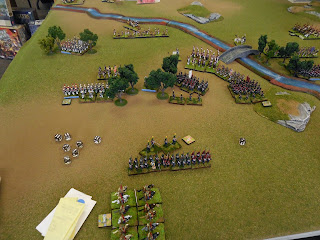For a change, we did an Anglo-Russian force against a French one set in 1813 in Germany. For the first time we got to have cossacks on the table and some Hanovarians instead of simply British and Portuguese as the opponent. In this scenario the French did not set up as we used a literal fog to hide French dispositions.
The light fog that was in play that limited vision until within 10 base widths. This fog would last 6 turns only. The "?" tickets on the table represent the suspected French positions but nothing more. The French would be able to set up how they wanted having already identified the enemy and waiting in defense until responding. The Allies took advantage of the fog to use march columns to pull up close.
On the French left, some marauding cossacks manage to spot the three battalions of the 70th line. The cossacks would need to wait for the infantry to catch up before pushing on with an attack.
On the French right, the British spot multiple French battalions along with a battery of artillery deployed and waiting. In the center of the French line, a couple of battalions become exposed, but what else could be behind?
>As the Russians advance along the French left, the three battalions of the 2nd légère are revealed as well as the reserve battery just to the right of the picture.
The French center is all out in the open now and a horse artillery battery is deployed probably a bit too close to the front. Not sure why the hill ended up on the stream here, took me a while to catch this and put it back where it was.
Here the Russians and French have mostly closed the gap and the French have left a clear line of sight for the deployed artillery and cavalry to soften the enemy and pounce when the moment is right.
Here the Russians have decided to split up around the grove of trees. The Austrian battery filling in for a Russian battery will actually never fire a shot the entire battle due to being too far back and not having an available target. The Russian uhlans in the rear can be seen moving more toward the center due to a lack of space to deploy.
The cossacks in the center of the field decided that their lance will be enough to win the combat. a bad die roll prevented the 1st battalion of the 4th légère to form square in time. The combat was a narrow victory for the French and a temporary one as Russian Semonovsky Life Guards moving through the woods finished the battalion off the following turn.
The light cavalry brigade on the French right wing move up to fill the gap and stem the tide against the aggressive Russian infantry. The horse artillery battery is having no real effect in either causing damage or in slowing the advance of the Russians.
Here the Russian guard battalion carried the position of the routed French unit and moved itself into a precarious position. The French légère battalions side step to the left to bring the maximum number of muskets to bear and soften up the guardsmen before trying to charge into them. We also had some chasseurs take some Russian infantry head on towards the top of the picture.
Now on the French left flank this was the the beginning of the second round of melées. The first one saw the cossacks and the infantry battalion on the far left going at it. the 3rd battalion of the 70th line failed to form square against the cossacks and was pushed back. The Russian infantry battalion was repulsed and now is receiving a combined attack by the 1st and 2nd battalions.
At the top we see the French battery upon the hill was taken out by a frontal British attack. The French chasseurs in the center are still battling it out against the Russian line unit. A Few Hanovarian battalions can be seen marching up as a late arrival to join the British comrades.
Coming back to the French left flank, we see the cossacks were successful in taking the 3rd battalion of the 70th line out. It failed to form square yet again and paid the price. The Russian infantry to the right tried to take out the French reserve battery. The guns knocked one battalion but are then was forced to limber up and move to the rear. The other two Russian battalions are forced to turn about and defend themselves. The melée in the trees in the center continues to go back and forth with Russians bouncing back during a series of inconclusive attacks.
The French cavalry were unsuccessful in the center and now some Allied artillery is trying to sweep away opposition in the center. Below, we can see the French 1st battalion 36th line atop the edge of the hill. It was successful in stopping the first Russian assault on this position.
The Russian guard unit that so boldly made an attack from the woods did an about face and try to continue its advance only to find itself hit by vengeful French troops. Had it been more patient or the Russians behind him advanced more rapidly, it might not end up getting obliterated in the ensuing combat.
In the center of the image, the French took a chance and attacked the British battery opposite. This attack was thrown back with the artillerymen more determined to hold their position than run. The British have taken control of the flank and are in a turning movement that will only gain momentum.
Here the 1st battalion of the 36th line moves downhill to attempt to break the Russian battalion that was previously thrown back. Russian uhlans have decided there isn't much to do here and form up and move back to the Russian right flank where they started.
The artillery on the Russian flank continues to sit and wait for something. The Russian troops in the wooded area were finally destroyed and the Russian battalion on the far flank continues to be driven back.
The cossacks are taking a bit of a break. Being at 3 hits, they are no longer able to charge and are trying to get to a safe spot and recover. The 1st battalion of the 2nd légère and the 2nd battalion of the 70th line about face in an attempt to pin and blow the cossacks out of their saddles.
Due to the cossacks running around so fast, the 2nd battalion of the 70th line decides to about face and over a couple of turns move up to outflank the artillery that will pose a problem when the Russian battalion here breaks. The French légère at the bottom miss in their firing and the cossacks escape another turn and fail to recover. The other battalions of the French 2nd légère repulsed a Russian infantry attack and the 3rd battalion counters the last Russian battalion in this sector. The Uhlans were pushed back from their first attack on the 2nd battalion. Again, the French failed to form emergency square but won the melée anyway. On their movement turn they formed a square to ward off the uhlans.
The French in the center were partially successful in taking out a battalion but had a battalion retreat back. The Russian artillery, with no real opposition here any longer, are boldly hoping to canister the French center into submission. The French right at this point is nothing more than a few units and a battery of artillery.
The French 3rd battalion loses its combat with the Russian battalion here and is repulsed. The 1st battalion at the bottom of the image doesn't manage to hit the cossacks while the 2nd battalion of the 70th is getting closer to the silent artillery battery.
The 2nd & 3rd battalions of the 36th line try to give one last push to the Russians here in the center. The 4th légère continues a long range musketry duel. Russian canister hits the 1st battalion of the 36th but inflicts little damage. The Russian battery here was also hit by French horse artillery canister shot, but managed to live through it all.
The remnants of the French right. The hussar and chasseur units are attempting to buy time but the inevitable cannot be denied. Any gains on the French left and center will not be fast enough to then engage the other Russian and British forces. The French must call the game. The British player was rolling well today and it shows in the minimal losses he suffered. The Russians were banged up but still stromg enough to not quit the field. Time to retreat deeper into Germany.

























Great looking figures and terrain. Very nice game!
ReplyDeleteThank you, Dean!
ReplyDelete